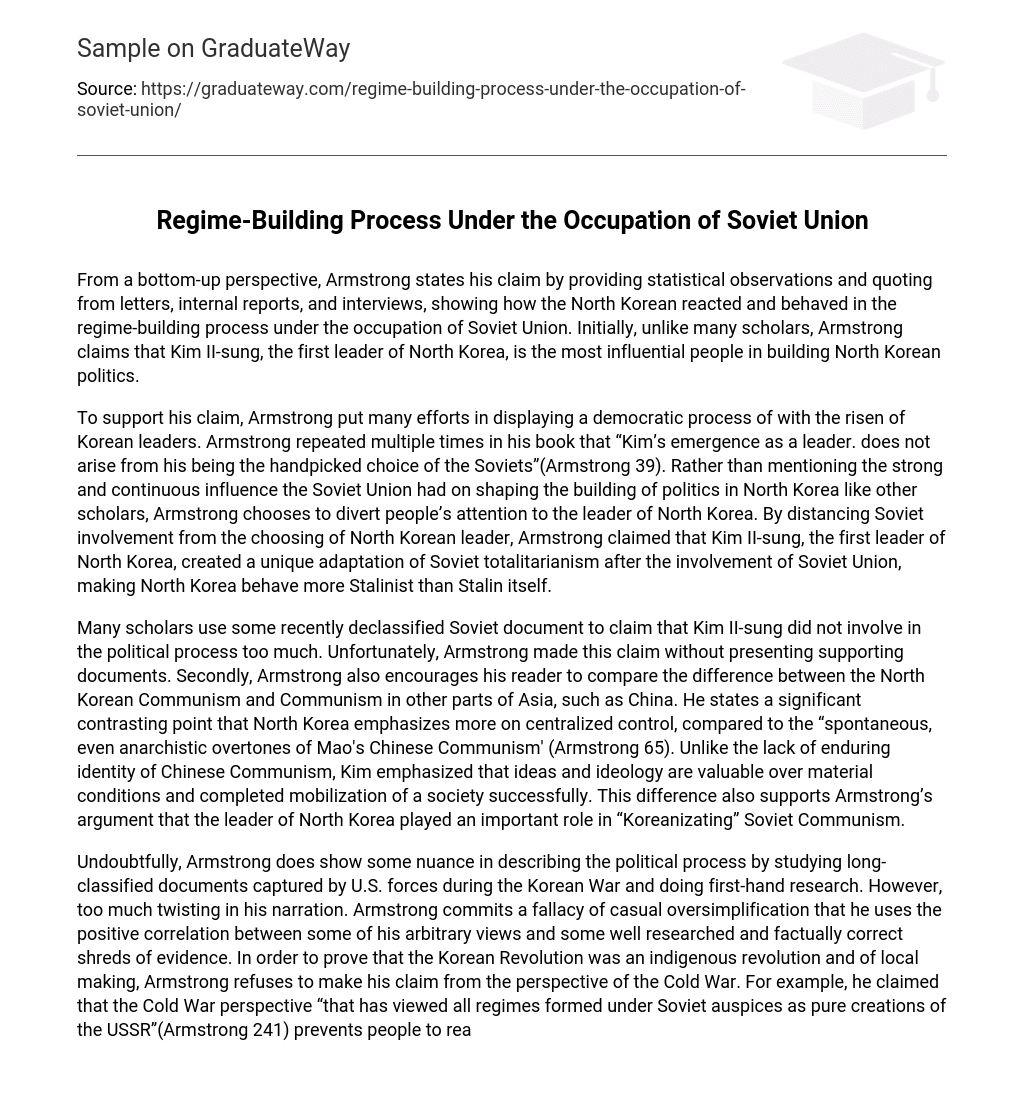From a bottom-up perspective, Armstrong states his claim by providing statistical observations and quoting from letters, internal reports, and interviews, showing how the North Korean reacted and behaved in the regime-building process under the occupation of Soviet Union. Initially, unlike many scholars, Armstrong claims that Kim II-sung, the first leader of North Korea, is the most influential people in building North Korean politics.
To support his claim, Armstrong put many efforts in displaying a democratic process of with the risen of Korean leaders. Armstrong repeated multiple times in his book that “Kim’s emergence as a leader. does not arise from his being the handpicked choice of the Soviets”(Armstrong 39). Rather than mentioning the strong and continuous influence the Soviet Union had on shaping the building of politics in North Korea like other scholars, Armstrong chooses to divert people’s attention to the leader of North Korea. By distancing Soviet involvement from the choosing of North Korean leader, Armstrong claimed that Kim II-sung, the first leader of North Korea, created a unique adaptation of Soviet totalitarianism after the involvement of Soviet Union, making North Korea behave more Stalinist than Stalin itself.
Many scholars use some recently declassified Soviet document to claim that Kim II-sung did not involve in the political process too much. Unfortunately, Armstrong made this claim without presenting supporting documents. Secondly, Armstrong also encourages his reader to compare the difference between the North Korean Communism and Communism in other parts of Asia, such as China. He states a significant contrasting point that North Korea emphasizes more on centralized control, compared to the “spontaneous, even anarchistic overtones of Mao’s Chinese Communism’ (Armstrong 65). Unlike the lack of enduring identity of Chinese Communism, Kim emphasized that ideas and ideology are valuable over material conditions and completed mobilization of a society successfully. This difference also supports Armstrong’s argument that the leader of North Korea played an important role in “Koreanizating” Soviet Communism.
Undoubtfully, Armstrong does show some nuance in describing the political process by studying long-classified documents captured by U.S. forces during the Korean War and doing first-hand research. However, too much twisting in his narration. Armstrong commits a fallacy of casual oversimplification that he uses the positive correlation between some of his arbitrary views and some well researched and factually correct shreds of evidence. In order to prove that the Korean Revolution was an indigenous revolution and of local making, Armstrong refuses to make his claim from the perspective of the Cold War. For example, he claimed that the Cold War perspective “that has viewed all regimes formed under Soviet auspices as pure creations of the USSR”(Armstrong 241) prevents people to realize that North Korea represents a unique ‘indigenization’ of Soviet Stalinism.
To support his view, Armstrong emphasizes the importance of Korean nationalism of pre-1945 Korean history in particular Confucianism and Japanese colonialism as important factors shaping the character of the North Korean regime and national identity. This view actually causes a lot of confusion. If this were only an internal conflict among Korean people like what Armstrong claims, why would people have to look for the influence of indigenous aspects? Throughout the book, Armstrong aims to convince people that indigenous aspects of North Korean rule including the Confucian heritage and leadership style are the main cause of the Soviet Stalinism.
He refers to all the sway of Confucian values over Kim II Sung’s Christian family background and Japanese colonialism, and all his remarks about Confucianism and colonial trades are correct to explain developments in North Korea before 1950. However, no evaluation of the meaning that such developments had for what followed and many often-contradictory explanations fail to build a sustainable and truthful argument that the documents he has chosen to support his claim do not work out. Hence, The North Korean Revolution fails to convince people.





